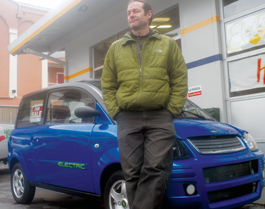home | metro santa cruz index | news | santa cruz | news article

Photograph by Curtis Cartier
Fuel Silly Yet?: In a ZENN world, even biodiesel would be unnecessary.
A State of ZENN
Now available in Santa Cruz: the car that may save the world
By Curtis Cartier
No one killed the electric car. In fact, you can get one today in Santa Cruz for about $13,000 after tax rebates. It may only go 25 miles per hour and fit two people with room for groceries, but it still costs pennies a mile to drive and is one of the greenest ways to get around town.
The ZENN, short for Zero Emissions No Noise, is a Canadian-made minimobile that looks like a Matchbox car, drives like a go-cart and saves money like bar soap. And with the reopening of the Green Station on the corner of Soquel Avenue and Ocean Street, co-owner Bill LeBon is looking to turn the biodiesel fuel station into a ZENN dealership as well.
"This is the perfect car to do 90 percent of your driving in," says LeBon as he unplugs the car's standard 12-volt extension cord. "It's all about having the right tool for the right job and this is the car for getting around town in."
The first of what LeBon expects to be many ZENNs currently sits in front of the station, its "For Sale" sign taking up about half of its diminutive windshield. Most closely resembling the Euro-favorite Smart car, only with a slightly extended front end and a couple of extra square feet of trunk space, the ZENN looks like a 1990s-era minivan shrunk to the size of a Mini Cooper. Inside, the view is similar to that of any other car although the speedometer and other gauges have been moved to the top of the center console on an LED screen. Common features such as power locks and windows, air conditioning, keyless entry and a sunroof are available, and "driving stick" has never been easier as the shifter covers three basic speeds: park, drive and reverse. The car has a 35-miles-per-charge range and takes about eight hours to charge. Turning the car on might leave some seasoned gas-guzzlers waiting for the other shoe to drop when the completely silent lead acid batteries click on without the familiar purr of a gasoline burner. Step on the pedal, however, and the ride bounces forward in an instant, its 1,200 pounds shot ahead effortlessly by the small motor.
For UCSC programs analyst and ZENN driver Joe Di Lellio, his electric car gets him around nine times out of 10 while his Honda Civic waits patiently for the occasional trip to San Jose or Monterey. Di Lellio was one of the first in California to buy a ZENN two years ago and says his experience has been stellar, including the time the car's race-car-style rollcage was put to the test in an intersection collision with the ZENN's arch-nemesis: the SUV.
"I just remember hearing the roar of the engine as it accelerated through the stop sign and slammed into us," he says. "The car bounced around like a cue ball. It was terrifying. But we were fine and we drove it away afterward."
For most drivers, the car's 25 mph speed limit presents the largest drawback to owning a ZENN. The cars are illegal to drive on the highway and can present dangers of being too slow in 35-mph zones. But that could all change soon, as ZENN Motors, in cooperation with the mysterious green tech research company EEStor, is locked in a race to develop an "ultracapacitator" that would bump the car's top speed up to 80 mph, increase its range to 250 miles and deliver a full charge to the batteries in five minutes. This holy grail of technology is the goal of EEStor and two other companies that industry experts say could turn into household names—if they finish first. EEStor and ZENN may have taken a commanding lead, however, with the Dec. 19 announcement that the company has secured a patent for a prototype ultracapacitator. Company execs are maintaining their vow of silence as to whether the patent marks the success of their research. They are, however, saying they hope to preview the new technology in the fall of 2009 as part of the city ZENN with its $30,000 price tag.
"This car would meet the transportation needs of 90 percent of the people out there," says Zenn spokeswoman Catherine Scrimgeour. "Aside from autos, this capacitator could change all kinds of other things. Imagine personal electronics—your laptop or cell phone could be charged once a month. It's a huge leap forward."
While the lab coats at EEStor continue to research the perfect electric car, ZENNs like the one sitting in front of the Green Station are available now, and though they may not satisfy the average American's need for speed, they will get people from point A to point B for about 3 cents per mile.
"We've got to get out of the mind-set that taking a pickup truck to the grocery store is OK," says LeBon as the ZENN pulls to a stop. "It's time for a change."
Send a letter to the editor about this story.
|
|
|
|
|
|